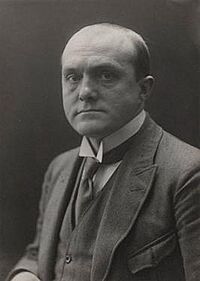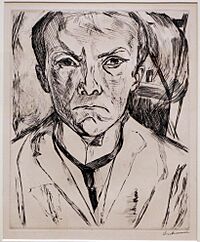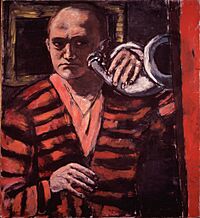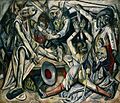Max Beckmann facts for kids
Quick facts for kids
Max Beckmann
|
|
|---|---|

Beckmann in 1922
|
|
| Born | February 12, 1884 |
| Died | December 27, 1950 (aged 66) New York City, New York, U.S.
|
| Nationality | German |
| Known for | Painting Sculpture Drawing Printmaking |
| Movement | New Objectivity Expressionism |
Max Beckmann (born February 12, 1884 – died December 27, 1950) was a famous German artist. He was a painter, draftsman, printmaker, sculptor, and writer. Even though some people called him an Expressionist artist, he didn't like that label.
In the 1920s, he was linked to a style called New Objectivity (Neue Sachlichkeit). This style was a bit different from Expressionism. It focused less on strong emotions and more on showing things clearly. Beckmann's art often had a serious or uneasy feeling, even when he painted fun subjects like circus performers. By the 1930s, his art became even more intense. It showed harsh images and twisted shapes, mixing real-life details with social messages. This happened as Nazism grew stronger in Germany.
Contents
Max Beckmann's Life Story
Early Life and World War I Impact
Max Beckmann was born in Leipzig, Germany, into a middle-class family. From a young age, he wanted to be as good as the old master painters.
During World War I, he volunteered as a medical helper. This experience was very difficult for him. It changed his art style a lot. His paintings went from being very realistic to having distorted figures and spaces. This showed how his view of himself and people had changed.
Self-Portraits and Deep Thoughts
Beckmann is famous for the many self-portraits he painted throughout his life. Only artists like Rembrandt and Picasso painted as many.
He loved to read about philosophy and literature. He also explored ideas like mysticism and theosophy. He was always searching for his true "Self". Beckmann was a painter who also thought deeply. He tried to find a hidden spiritual meaning in his subjects.
Success and Recognition
Beckmann became very successful during the Weimar Republic in Germany. In 1925, he was chosen to teach at the Städelschule Academy of Fine Art in Frankfurt. Some of his well-known students included Theo Garve and Marie-Louise von Motesiczky.
He received important awards in 1927. The National Gallery in Berlin bought two of his paintings, The Bark and Self-Portrait in Tuxedo. By the early 1930s, many big art shows and books showed how highly Beckmann was respected.
Facing Nazi Persecution
Things changed for Beckmann when Adolf Hitler came to power. Hitler disliked Modern Art and quickly banned it. In 1933, the Nazi government called Beckmann a "cultural Bolshevik." They fired him from his teaching job in Frankfurt.
In 1937, the government took more than 500 of his artworks from German museums. They even showed some of them in a terrible exhibition called Degenerate Art in Munich. The day after Hitler's speech about "degenerate art," Beckmann and his second wife, Quappi, left Germany for the Netherlands.
Life in Exile and Move to the U.S.
Beckmann lived in Amsterdam for ten years. He tried hard to get a visa to the United States, but it was difficult. In 1944, even though he was 60 and had a heart attack, the Germans tried to make him join the army.
The paintings he made in Amsterdam were even more powerful. They included several large triptychs, which are paintings with three panels. These works showed the best of Beckmann's art.
In 1947, Beckmann moved to the United States. He taught at the St. Louis School of Fine Arts at Washington University. He also taught at the Brooklyn Museum. The first big show of his art in the U.S. happened in St. Louis in 1948. A collector named Morton D. May became his supporter and student. May later gave many of Beckmann's paintings to the St. Louis Art Museum.
Final Years in New York
After teaching in St. Louis, Beckmann and Quappi moved to Manhattan, New York. In 1949, he became a professor at the Brooklyn Museum Art School.
Beckmann had heart problems. He died on December 27, 1950, from a heart attack in New York City. He was on his way to see one of his paintings at the Metropolitan Museum of Art. In the year he died, his art was shown at the Venice Biennale. Also in 1950, he painted Falling Man. This painting is seen as a reflection on life and death. It also seemed to predict the people falling from the World Trade Center Towers during the September 11 attacks.
Themes in Max Beckmann's Art
Artistic Style and Influences
Unlike some artists of his time, Beckmann did not paint non-representational art. He continued the tradition of painting recognizable figures and scenes. He admired artists like Cézanne, Van Gogh, Rembrandt, and Rubens. He also liked Northern European artists from the late Middle Ages and early Renaissance, such as Bosch and Bruegel. His painting style was partly inspired by medieval stained glass.
Exploring Modernism and Human Experience
Beckmann painted portraits, landscapes, still life, and history scenes. His art was very personal but also showed a unique version of modernism. He respected traditional art forms. He even brought back the religious triptych (a three-panel painting) and used it to tell stories about modern people.
Beckmann's art shows the big changes in art and history from the early 1900s to after World War II. Many of his paintings show the struggles in Europe during the first half of the 20th century. Some of his art hints at the fancy, wild cabaret culture of the Weimar Republic. But from the 1930s, his works often used myths to talk about the cruelties of the Nazis. Beyond these specific events, his art explores bigger ideas like fear, hope, and the mysteries of life and destiny.
Symbolism in His Work
His Self-Portrait with Horn (1938), painted while he was in exile, shows how he used symbols. Musical instruments appear in many of his paintings. In this one, he holds a horn as if it's a telescope, looking into the darkness around him. The way he is tightly framed in the painting makes him seem trapped. An art historian called this painting "the most sad, but also the most mysterious, of his self-portraits."
Max Beckmann's Legacy
Many of Beckmann's later paintings are in American museums. He had a big impact on American painters like Philip Guston. He also influenced a movement called Boston Expressionism, which later became American Figurative Expressionism.
His unique art style made it hard for art critics to easily categorize him. For many years, his work was not widely seen in the United States. However, the Saint Louis Art Museum has the largest public collection of his paintings in the world. They held a major exhibition of his work in 1998.
Since the late 1900s, Beckmann's art has become more famous around the world. There have been many big art shows of his work in New York, Rome, London, Paris, and other major cities. This has allowed more people to see his art.
The Max Beckmann Archiv was created in 1977 to preserve his work and information about him. Beckmann was also a talented writer. His letters, essays, plays, and diaries are important historical documents.
In 2003, Stephan Reimertz wrote a biography about Max Beckmann. It included many new photos and details. The book showed how Beckmann thought about writers and thinkers like Dostoyevsky and Nietzsche.
Max Beckmann in the Art Market
Even though Beckmann is an important artist, he isn't as famous as some others. His works have mostly been bought by collectors from Germany and Austria. In 1921, Beckmann signed a special contract with an art dealer in Berlin. In 1938, he had many shows at a gallery in New York.
Today, Beckmann's large paintings often sell for more than $1 million. His self-portraits usually sell for the highest prices. In 2001, a painting called Self-Portrait with Horn (1938) sold for $22.5 million. In 2017, his painting Hölle der Vögel (Birds' Hell) (1938) sold for a record $45.8 million. This was the highest price ever paid for a German Expressionist artwork. In 2022, Self-Portrait Yellow-Pink (1943) sold for 20 million euros (about $20.7 million) in Germany. This was a record for an art auction in Germany.
Rediscovered Works
In 2012, several important works by Beckmann were found in the apartment of Cornelius Gurlitt in Munich. Experts are carefully checking where these artworks came from. They want to know if they were sold during the Nazi period.
See also
 In Spanish: Max Beckmann para niños
In Spanish: Max Beckmann para niños
- Beckmann and Theosophy
- Expressionism
- New objectivity
Images for kids




